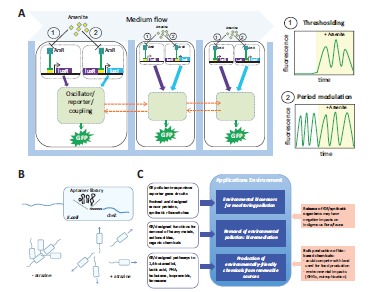Fig. (2).

Synthetic biology approaches to environmental applications. A. Whole-cell biosensor array that is frequency-modulated by arsenite [55]. The array consists of multiple E. coli colonies (“biopixels”; schematically represented by single cells, black rounded rectangles) growing in wells of a microfluidic device (light blue), through which media can be pumped (top). Cells contain an oscillator module based on genetic quorum-sensing circuits (light green), producing synchronized oscillations of the expression of H2O2 and of green fluorescent protein (GFP). H2O2 can migrate between colonies and synchronize them by affecting the oscillator module. This genetic oscillator was coupled to one of two arsenite sensor modules (1 or 2) containing parts of the oscillator (luxR or luxl genes) under the control of an arsenite-responsive repressor protein (ArsR) and its cognate promoter element (yellow box). Oscillation can thus either be switched on/off (thresholding, 1) or modulated in frequency (period modulation, 2) by arsenite and measured via GFP fluorescence (panels on the right). B. Generation of synthetic riboswitches to generate bacteria that detect, follow and can destroy the herbicide atrazine [53]. A library of atrazine-binding small RNAs (aptamers) selected in vitro was inserted into the 5'-untranslated region of the cheZ gene that controls E. coli motility, upstream of a randomized sequence (NNN, upper panel). Together with an aptamer, the randomized sequence can become part of a riboswitch element that couples ligand binding and translational control of cheZ mRNA. By functional screening, riboswitches were selected that mediated atrazine-dependent cell motility (bottom panel). When an atrazine-degrading enzyme is introduced, the cells migrate towards atrazine and degrade it. C. Overview of approaches related to synthetic biology addressing environmental issues (open blue boxes) and of their potential applications/ assets (filled blue boxes) and associated challenges/risks (filled red boxes). GE, genetically engineered; GHGs, greenhouse gases; PHA, polyhydroxy-alkanoates.
